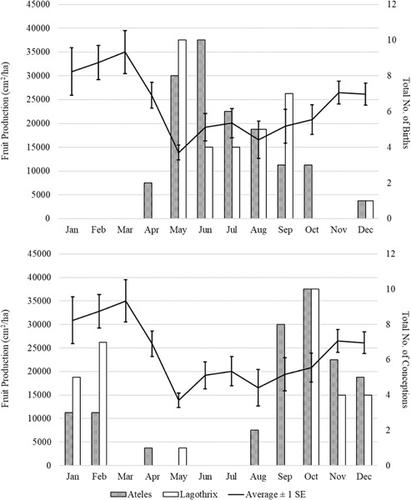当前位置:
X-MOL 学术
›
Am. J. Primatol.
›
论文详情
Our official English website, www.x-mol.net, welcomes your
feedback! (Note: you will need to create a separate account there.)
Reproductive seasonality in two sympatric primates (Ateles belzebuth and Lagothrix lagotricha poeppigii) from Amazonian Ecuador
American Journal of Primatology ( IF 2.0 ) Pub Date : 2020-12-02 , DOI: 10.1002/ajp.23220 Kelsey M Ellis 1, 2 , Laura A Abondano 1 , Andrés Montes-Rojas 3 , Andrés Link 3, 4 , Anthony Di Fiore 1, 4
American Journal of Primatology ( IF 2.0 ) Pub Date : 2020-12-02 , DOI: 10.1002/ajp.23220 Kelsey M Ellis 1, 2 , Laura A Abondano 1 , Andrés Montes-Rojas 3 , Andrés Link 3, 4 , Anthony Di Fiore 1, 4
Affiliation

|
With their large body size and “slow” life histories, atelin primates are thought to follow a risk‐averse breeding strategy, similar to capital breeders, in which they accumulate energy reserves in anticipation of future reproductive events such as gestation and lactation. However, given the paucity of longitudinal data from wild populations, few studies to date have been able to compare the timing of reproductive events (e.g., copulations, conceptions, and births) in relation to shifting resource availability over multiple years. We examined the reproductive patterns of two atelin species—white‐bellied spider monkeys (Ateles belzebuth) and lowland woolly monkeys (Lagothrix lagotricha poeppigii)—in relation to habitat‐wide estimates of fruit availability at the Tiputini Biodiversity Station (TBS) in Amazonian Ecuador. Our sample included 4 years of data on births (N = 36) and copulations (N = 170) for Lagothrix, 10 years of data on births (N = 35) and copulations (N = 74) for Ateles, and 7 years of data on ripe fruit availability. Reproductive events were distinctly seasonal. For both species, births were concentrated between May and September, a time period in which ripe fruit was relatively scarce, while inferred conceptions occurred between September and January, when ripe fruit availability was increasing and maintained at high‐levels throughout the forest. Interannual variation in births was relatively stable, except for in 2016 when twice as many infants were born following a strong El Niño event that may have led to unusually high levels of fruit productivity during the 2015 breeding season. Although copulations were observed year‐round, an overwhelming majority (>90% for Lagothrix and >80% for Ateles) took place between August and February when females were most likely to conceive. Collectively, these data follow the reproductive patterns observed in other atelin primates, and, as proposed by others, suggest that atelins may follow a risk‐averse breeding strategy.
中文翻译:

来自亚马逊厄瓜多尔的两种同域灵长类动物(Ateles belzebuth 和 Lagothrix lagotricha poepppigii)的繁殖季节性
由于它们的体型庞大和“缓慢”的生活史,阿特林灵长类动物被认为遵循一种规避风险的繁殖策略,类似于资本繁殖者,在这种策略中,它们积累能量储备以预测未来的生殖事件,如妊娠和哺乳期。然而,由于缺乏来自野生种群的纵向数据,迄今为止,很少有研究能够将繁殖事件(例如,交配、受孕和出生)的时间与多年变化的资源可用性进行比较。我们检查了两种 atelin 物种——白腹蜘蛛猴 ( Ateles belzebuth ) 和低地长毛猴 ( Lagothrix lagotricha poepppigii )的繁殖模式。)——关于在厄瓜多尔亚马逊河流域的蒂普蒂尼生物多样性站 (TBS) 的全栖息地水果供应估计。我们的样本包括4年数据的关于出生(Ñ = 36)和交配(Ñ = 170),用于Lagothrix,关于出生10年的数据的(Ñ = 35)和交配(Ñ = 74),用于Ateles,以及 7 年关于成熟水果可用性的数据。生殖事件具有明显的季节性。对于这两个物种,生育集中在 5 月和 9 月之间,在此期间成熟果实相对稀少,而推断受孕发生在 9 月和 1 月之间,此时成熟果实的可用性增加并在整个森林中保持在高水平。出生率的年际变化相对稳定,但在 2016 年,在强厄尔尼诺事件之后出生的婴儿数量翻了一番,这可能导致 2015 年繁殖季节水果生产力水平异常高。尽管全年都可以观察到交配,但绝大多数(Lagothrix > 90%和Ateles > 80%) 发生在八月和二月之间,当时女性最有可能怀孕。总的来说,这些数据遵循在其他 atelin 灵长类动物中观察到的繁殖模式,并且正如其他人提出的那样,表明 atelin 可能遵循规避风险的繁殖策略。
更新日期:2021-01-04
中文翻译:

来自亚马逊厄瓜多尔的两种同域灵长类动物(Ateles belzebuth 和 Lagothrix lagotricha poepppigii)的繁殖季节性
由于它们的体型庞大和“缓慢”的生活史,阿特林灵长类动物被认为遵循一种规避风险的繁殖策略,类似于资本繁殖者,在这种策略中,它们积累能量储备以预测未来的生殖事件,如妊娠和哺乳期。然而,由于缺乏来自野生种群的纵向数据,迄今为止,很少有研究能够将繁殖事件(例如,交配、受孕和出生)的时间与多年变化的资源可用性进行比较。我们检查了两种 atelin 物种——白腹蜘蛛猴 ( Ateles belzebuth ) 和低地长毛猴 ( Lagothrix lagotricha poepppigii )的繁殖模式。)——关于在厄瓜多尔亚马逊河流域的蒂普蒂尼生物多样性站 (TBS) 的全栖息地水果供应估计。我们的样本包括4年数据的关于出生(Ñ = 36)和交配(Ñ = 170),用于Lagothrix,关于出生10年的数据的(Ñ = 35)和交配(Ñ = 74),用于Ateles,以及 7 年关于成熟水果可用性的数据。生殖事件具有明显的季节性。对于这两个物种,生育集中在 5 月和 9 月之间,在此期间成熟果实相对稀少,而推断受孕发生在 9 月和 1 月之间,此时成熟果实的可用性增加并在整个森林中保持在高水平。出生率的年际变化相对稳定,但在 2016 年,在强厄尔尼诺事件之后出生的婴儿数量翻了一番,这可能导致 2015 年繁殖季节水果生产力水平异常高。尽管全年都可以观察到交配,但绝大多数(Lagothrix > 90%和Ateles > 80%) 发生在八月和二月之间,当时女性最有可能怀孕。总的来说,这些数据遵循在其他 atelin 灵长类动物中观察到的繁殖模式,并且正如其他人提出的那样,表明 atelin 可能遵循规避风险的繁殖策略。











































 京公网安备 11010802027423号
京公网安备 11010802027423号